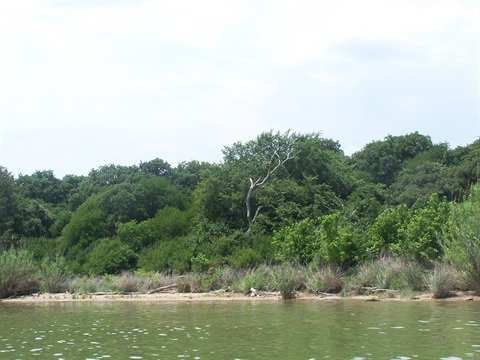Goat Island Park

Dedication
Size
Additional amenities
Fun facts
History
Goat Island was formed with the creation of Lake Worth in 1911-14. The six-acre park is located in the middle of the lake between Mosque Point on the east and Wildwood Park on the west. A newspaper article from 1919 indicates that the island received its name as a result of two gentlemen who rafted their goat herd to the island for sustenance during a drought (Ref: “Exploring Lake Worth's Shore Line in a Motor Boat”; Fort Worth Star-Telegram - August 24, 1919). For years, it was illegal for visitors to the lake to use the park because there were no sanitary facilities on the island. In 1958, the park board worked out a preliminary agreement with a concessioner at Casino Beach to provide boat rides to the island with the park department to receive ten per cent of the receipts. Although it was considered city-owned land, it wasn’t officially designated as a city park until November 1970. Today, there are no recreational improvements in the park.
Recreation
Though accessible from the various boat ramps around the lake, those who are inclined to power themselves to the island (e.g. kayak), and not needing a ramp will likely find Sunset Park (0.8 miles to the island) or Camp Joy Park (0.9 miles to the island) as being good launch locations. A kayak tour around the island is about 1-3/4 miles or so. If you visit the park, please take a trash bag and pick up litter while you're there.
Geology
Goat Island Park is on a sliver of land rising out of the southwest reaches of Lake Worth. The island was created when Lake Worth was impounded. It has narrow beaches around most of its circumference, with some higher steeped banked edges too. The exposures of bedrock can be seen at various locations around the island, particular at the east end. They are likely of the Paluxy Formation or Walnut Clay of the Cretaceous Period. There are also exposures of unconformally deposited and highly compacted Quaternary gravels likely deposited on benches along the original Trinity River course.
Soils
The park soils and underlying deposits are largely made up of sandy loam soil and Quaternary Alluvium. The Duffau-Windthorst complex of soils comprises most of the island. This is a highly erodible sandy and loamy residuum weathered from sandstone and siltstone of the Cretaceous Age. (If you visit the park, walk delicately upon the soil as it is essentially beach sand.) These soils are often found on footslopes and backslopes of ridges. The northern tip of the island is comprised of Maloterre, Aledo, and Brackett soils. These are moderately slow permeable soils that formed in residuum weathered from limestone of the Cretaceous (Maloterre) as well as layered limestone and marl (Aledo and Brackett). These soils occupy gently sloping to moderately steep benched uplands and backslopes.
Ecology
The park consists mostly of post oak woodland with live oak mottes at the higher altitudes on the east end of the island, and floodplain hardwoods along the edge. Accordingly there is yucca including the endemic Glen Rose yucca (Yucca necopina) in the highly sandy soil. The Fort Worth Zoo designated Goat Island as monarch habitat and planted zizotes milkweed in the grassy, open areas. Green milkweed, another monarch favorite, is naturally-occurring on the island. Other species include prickly pear cactus, thistle, hackberry, sycamore, eastern red cedar, little bluestem, switchgrass, prairie dropseed and other native grasses. Thick woodlands run through much of the central and westerly areas of the park. Many types of Carex sedge are found sporadically throughout the park, and especially along the shoreline edges with rushes as well.
View animal, plant and insect species observed at Goat Island and make some of your own observations through iNaturalist. See link under the "Related information" Section.
Reserve this park on ActiveNet
Location
8298 Malaga Drive, Fort Worth 76135 View Map
32.8044319,-97.46026409999999
8298 Malaga Drive ,
Fort Worth 76135
8298 Malaga Drive ,
Fort Worth 76135
Goat Island Park
Photo Gallery